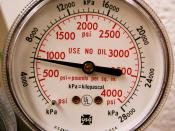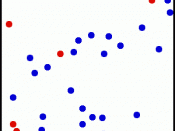Gases pressure is exerted by gas particles hitting the walls of the containerweakest intermolecular force (hydrogen) --> out of all the gases going to most obey ÃÂGas particles neither attract nor repel each otherÃÂ (#3 of kinetic theory of gases)PressureWhy is stepping on a nail more painful than lying on a bed of nails?-force exerted by your mass is spread out over a larger area (when one lies on a bed of nails) compared to when you step on a nail, so you feel less pain.
equation for pressure --> P = F/A F - force, A - Areachanging the area --> increase the area (pressure decreases)decrease in area àpressure increasesliquids and gases can also exert pressureBarometer --> measures air pressureair particles hit the surface of surface of mercury-the higher the room pressure --> more air molecules hitting the surface, exerting downward pressure causing the level of mercury in the tube to risethe average room pressure is 760 mm of the mercuryIdeal Gas àbehaves according to the Kinetic Theory of Gases-no gas does this completely-Gases do exhibit minimum amounts of attraction (H2 , He show the least)-All particles have volume (its only relevant at extremely high pressures)BoyleÃÂs LawP (pressure) and V (volume); variable â T (temperature) & n (constant - # of moles)-relationship between P and V is inversely proportional-downward curve starting at high volume (neither approaches zero)1) If volume is doubled àpressure decreases by half2) If pressure is tripled àvolume decreases to 1/3 of the original volumePV = constantP1V1 = P2V2Units of pressure: Pascals (Pa)PSI1 mm Hg = 1 torratmair pressure at sea level - 1 atm1 atm = 760 mm Hg = 760 torrimploding soda can --> external pressure > internal pressurewhen you heat the soda can with water inside â little bit...


